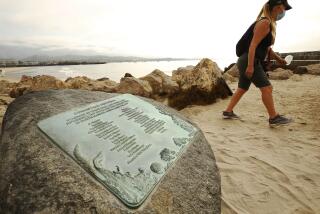Tragedy at Sea Pits What-Ifs Against Legal Proof : Law: Hopes of a court victory fade for family of fisherman who died near naval target range.
A commercial fisherman, Boyd Reber was trawling for soupfin shark near San Clemente Island five years ago. Late one night, he phoned his house near Poway to tell his wife, Cindy, that all was well.
He was never heard from again.
Records would later show that the sea was calm, the waves unexceptional. Days after the call, Reber’s boat was located in pieces. The stern was sheared off, as if from a blast. Just offshore, entangled in a kelp bed, searchers found Reber’s body, clad in a sweat shirt and jeans.
For 40 years, U.S. Navy ships have used San Clemente Island for target practice. The week Reber died, three Navy ships conducted gunnery practice, shelling the island.
Claiming that the Navy caused her husband’s death because no one or nothing else could have, Cindy Reber and her daughter, Courtney, sued the federal government, seeking $2.5 million in damages. A San Diego federal judge turned her down. Two weeks ago, by a 2-1 vote, so did a federal appeals court. Without added review, which is rarely granted, the case is over.
A study in the difference between possibilities and probabilities, the case underscores the tensions at work in reconciling real-life mysteries to the abstract legal standards--and obscure legal maxims--that reign in court. In an era of headline-grabbing million-dollar verdicts, it also serves as a reminder that a day in court is sometimes the only solace the system offers.
For Cindy Reber, her 9-year-old daughter and their supporters, who have been searching for five years for answers, the case has shaken their faith in the judicial system.
“I don’t think we’ve gotten justice,” Cindy Reber said last week. “ . . . I honestly can say I thought we would have a chance to show our side of this. I don’t feel that now. I don’t feel someone is there listening to everything, looking at the whole picture.”
“I don’t have any respect for the federal judicial system anymore,” said Tim Houshar, a Point Loma fisherman and Boyd Reber’s best friend. “I was afraid of it from the beginning. My fears have come true.”
The Reber family’s lawyer, Michael W. McCann of Santa Barbara, said he, too, is bothered. Rejected first by U.S. District Judge J. Lawrence Irving in San Diego and then Aug. 13 by a three-judge panel of the U.S. 9th Circuit Court of Appeals, McCann said he filed a bid for further appeal last Friday to an expanded, 11-judge 9th Circuit Court.
The San Francisco-based 9th Circuit, the federal appeals court that serves California and eight other Western states, grants expanded review infrequently. The odds are slim, McCann said.
“This is just a real tragedy,” he said, adding, “I got emotionally involved with this case.” The decisions by Irving and by the 9th Circuit Court, he said, seem “contrary to the evidence. Frankly, I’m a little disillusioned about the justice system as a result of this case.”
Irving, widely respected and considered one of the keenest federal judges in San Diego until he left the bench last year, flatly denied any bias in favor of the government. “I tried to be the most impartial human being alive,” he said last week. “I ruled against the government any number of times. I was never reluctant to rule against the government.”
Irving, who quit the bench because of frustration over harsh new sentencing rules in criminal cases, said he clearly remembered the case, which he tried without a jury in February, 1989.
“I just felt that (the Rebers) didn’t prove it,” he said. “I felt sorry for the people. They’re very nice people. But you can’t base decisions on that.”
At the house that Boyd and Cindy Reber moved into four months before his death, Boyd Reber’s clothes still hang in the closet. His hunting trophies still adorn the walls. The phone is still in his name. “He’s very much still alive in this house,” Cindy Reber said.
Courtney Reber was 4 when she lost her dad. She “still has what I call ‘Boyd Attacks,’ ” her mother said. “She will be doing something--drawing, playing--and she’ll come running to me and say, ‘Mom, I miss Daddy.’ She gets emotional. It’s still as fresh as right after the accident and it’s been 5 1/2 years.”
An experienced commercial fisherman, Boyd Reber, 38, set out Feb. 21, 1986, for San Clemente aboard his custom-built, 37-foot boat, the Cindy Fay. With him was crewman Frank Germano, 21.
At 7 p.m. Feb. 23, Reber called his wife. The fishing was good, he said. He told her he loved her.
Shortly after 8 a.m. March 2, Reber’s body was found in the kelp. The following day, Germano’s body was sighted on shore. In 35 feet of water lay heavy metal objects that had been on the stern of the boat.
An autopsy revealed that Reber suffered a broken nose, broken bones above his eyes and several forehead cuts, but that he died by drowning. He wasn’t wearing a life vest. The coroner put the time of death at less than a week before March 2. Germano suffered internal injuries on the left side of his body. The coroner said he died of cuts to his left lung and liver.
From Feb. 24 to 27, the Navy conducted three bombardment exercises at San Clemente Island. The Rebers’ wrongful-death suit claimed that an unexploded bomb on the ocean floor detonated while the boat’s nets were being pulled in or that a 5-inch shell fired sometime during the three-day barrage overshot its target and exploded on or near the boat.
Eventually, the overshot-shell theory was discredited. That left the unexploded-bomb claim. The Rebers contended that one of the bombs dropped over the past 40 years of naval bombardment suddenly exploded under the Cindy Fay when it was disturbed by the boat’s huge gill net.
Germano’s estate brought a separate lawsuit against Reber’s insurance carrier and settled for a nominal sum, McCann said.
To prevail in a civil lawsuit, the usual rule is that the person filing the suit--called the plaintiff--must prove a claim by what legal jargon terms a “preponderance of the evidence.”
According to lawbooks, that means the evidence shows that it’s more likely than not that something--whatever it is--happened and that the defendant--the person being sued--caused it.
The civil standard is far less demanding than what’s required in a criminal case, the familiar proof “beyond a reasonable doubt,” meaning certain beyond question. If, in a civil case, 50.1% of the evidence supports a claim but 49.9% does not, that 50.1% is still enough to tip the scale, to prove the claim.
Or, put another way, something must be probable, not just possible.
To prove probability, plaintiffs for centuries have been able to rely on a legal quirk carried on from old England--the doctrine of res ipsa loquitur. Meaning “the thing speaks for itself,” the doctrine applies in cases, like the Reber suit, where the plaintiff can’t show specifically what the defendant did--because, for instance, there are no witnesses. What the plaintiff can show is that someone obviously was negligent, it wasn’t the plaintiff and it was more than likely the defendant.
Boyd Reber went fishing in an area where there were unexploded shells, attorney McCann said. Reber’s boat was found in pieces and he was killed. The probability, he claimed, is that a shell blew up under the boat.
What else, McCann said at the trial, could it be?
It wasn’t foul weather, he said. Navy records from the last days of February, 1986, showed ripple waves, swells of 5 to 6 feet and winds of 10 to 16 knots, according to trial records. And if there had been a bad storm, Reber would have worn a raincoat or life vest, not just a sweat shirt and jeans.
It also wasn’t big surf, McCann said. The wreck must have occurred in deep water because, 35 feet down on the sea floor, divers found so many metal objects that had been on the stern.
It wasn’t a rogue wave, either, McCann said. To capsize a 37-foot boat in 35 feet of water would require a 27-foot wave breaking on top of the craft, according to an oceanographic expert who testified at the trial. That just didn’t happen in the winds the Navy logged, the expert said.
At the trial, government attorneys said the Reber case was based on surmise, not proof. In his closing argument, Assistant U.S. Atty. Warren Schneider said: “Nobody knows what happened to the Cindy Fay. Nobody ever will know what happened to the Cindy Fay.” Schneider did not return phone calls last week for comment.
Irving sided with the government. He ruled that proving what hadn’t happened was not the same as showing affirmatively the probable cause of the accident. An underwater explosion, he said in ruling from the bench, “is a possibility” but not proof by a preponderance.
In an opinion issued Aug. 13, the divided three-judge panel of the 9th Circuit court said it could not say for sure that Irving was wrong.
Judge Procter Hug Jr. stressed that the Rebers had the burden of proving that military negligence caused Boyd Reber’s death. “The burden is not on the government to prove what caused the death,” Hug said. “Nor is the burden on the government to prove a negative, i.e., that they did not cause the death.”
Irving found that the Rebers had not met their burden, Hug said. On appeal, “based on a cold record, we can not say that finding was clearly erroneous,” Hug said.
Judge Robert R. Beezer joined in the opinion.
Judge John T. Noonan, however, dissented, saying the majority opinion was nonsense and that he would reverse Irving’s ruling. Since, at the trial, lawyer McCann had put on witnesses to prove that the accident was not caused by weather or surf, Noonan asked, “What was left?”
“On old maps of the world there used to be a terra incognita sometimes marked: ‘There be monsters here.’ If we still believed in sea monsters, we could ascribe the wreck of the Cindy Fay to these beasts,” Noonan said. “But we don’t and we can’t.
“Similarly, we cannot suppose that Martians or pirates descended upon the boat, taking nothing but breaking it apart.
“The possibility that the Cindy Fay was wrecked by an unexploded Navy bomb is the only possibility that remains. Once it is the only possibility that remains, it becomes more likely than not that it is what happened. We know the wreck occurred. We know that every other explanation does not hold up. The possibility converts itself into a probability.”
Cindy Reber said Noonan’s dissent gives her hope that an expanded 9th Circuit Court will look again at the case. She said it also renews her faith in the system, but only by a bit.
“When you’re going through federal court, what can you do? You can try and hope there are more Judge Noonans out there,” she said. “We knew it was a big obstacle. We’ve tried to do what we can do.”
More to Read
Sign up for Essential California
The most important California stories and recommendations in your inbox every morning.
You may occasionally receive promotional content from the Los Angeles Times.










